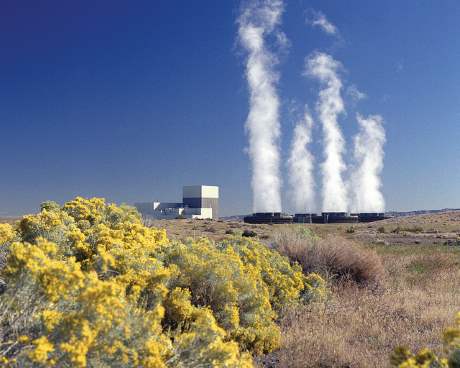Replacing Washington State's only operating nuclear power plant, the Columbia Generating Station, with wind and solar resources would lead to annual costs of $271 million, a new analysis by the Oregon-based Public Power Council (PPC) has found. The findings directly contradict those of a study circulated earlier this year by the anti-nuclear Physicians for Social Responsibility group.
 |
| Columbia Generating Station (Image: US Nuclear Regulatory Commission) |
The PPC, which represents the Pacific Northwest's consumer-owned utilities on issues in the region, reviewed the findings and methodology of a 48-page study by McCullough Research that claimed closing Columbia and replacing it with wind and solar resources would save customers in the region between $261.2 million and $530.7 million from March 2017 to June 2026.
According to the PPC, the McCullough report based its conclusions on an analysis alleging that the energy from Columbia could be replaced at a lower cost from renewables, and that the replacement of the plant's output with intermittent, non-dispatchable resources would not impact reliability or resource adequacy. "[B]oth of these conclusions are incorrect and substantially misleading," the PCC found. "Based on analysis from the Northwest Power and Conservation Council [NWPCC] as well as BPA [Bonneville Power Authority] rate information, the McCullough report's recommendations actually would lead to a cost of $271 million annually and would adversely affect regional power supply adequacy," PPC said.
The PPC questioned the McCullough report's use of levelised costs of energy for solar and wind from national rather than regional projections, using median values of $42.50 per MWh for new solar capacity and $31 per MWh for new wind.
"Although these values might be realistic in some circumstances, they are wildly inconsistent with the values produced specifically for this region by the NWPCC … Although the report cites the NWPCC and the Seventh Power Plan in other instances, the choice to rely on a minimally documented, national level report for levelised resource costs rather than the extensively vetted regional analysis used by the NWPCC is not explained," it says, "drastically understating" the cost of new renewable resources.
Based on its own analysis of NWPCC and BPA figures, the PPC estimated the least expensive replacement for Columbia's power would be utility scale solar facilities in Idaho, at a total cost of $78.84 per MWh. The average projected cost of power for Columbia from 2017 to 2026 - including the cost for transmission - would be $48.50 per MWh.
The NWPCC is a compact of the states of Idaho, Montana, Oregon and Washington responsible for developing regional long-term power plans as well as fish and wildlife programs. It is required under the 1980 Northwest Power Act to give priority to cost-effective energy efficiency, followed by cost-effective renewable resources, when developing its 20-year energy plans which are revised every five years. The PPC based its analysis on information from the NWPCC's Seventh Northwest Power Plan, which was adopted in February 2016.
The McCullough report was circulated to news media by Physicians for Social Responsibility following its publication in February. Brent Ridge, chief financial officer of Columbia owner and operator Energy Northwest, said of the McCullough Report yesterday: "It's unfortunate that such a poorly researched, anti-nuclear energy report garnered extensive media coverage. Columbia's carbon-free nuclear energy is a great value to region."
Columbia's single boiling water reactor has a gross output of 1190 MWe and has been operating at a capacity factor above 93% since 2012, Energy Northwest said yesterday. The plant is the third largest generator of electricity in Washington State and sells all of its output, at cost, to the BPA.
Researched and written
by World Nuclear News




_47120.jpg)

_23621.jpg)






